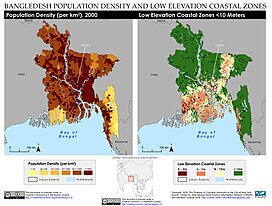The Low Elevation Coastal Zone (LECZ) refers to low-lying coastal areas with an elevation below a certain threshold, commonly 10 meters, above mean sea level. Globally, there is a substantial and growing population living in the Low Elevation Coastal Zone, which consists of approximately 2% of the world's land area and around 11% of the global population.[1][2][3] The LECZ is an area of interest because it represents areas that are and will be vulnerable to impacts of flooding and sea level rise due to climate change.[4]

Definition and Derivation edit
The term Low Elevation Coastal Zone was defined as "the contiguous area along the coast that is less than 10 metres above sea level" in a 2007 paper by McGranahan et al.,[5] although since then various elevation thresholds such as 5 meters have been used to define the LECZ for research purposes. The LECZ is derived using elevation data and also incorporates data on population density.[1] The LECZ includes places on land with elevations below sea level, as well as areas of land that are above sea level but are below a specified threshold. It represents the population in a region that may be vulnerable to impacts of present and future flooding and sea level rise.[4]
Estimates of the LECZ edit
The Low Elevation Coastal Zone has been estimated and mapped for the globe as well as for many countries, territories, and cities by the Socioeconomic Data and Applications Center at Columbia University as part of NASA's Earth Observing System Data and Information System (see maps here) as well as by researchers.
The Intergovernmental Panel on Climate Change's Special Report on the Ocean and Cryosphere in a Changing Climate includes a figure (Figure CB9.1) that is a global map of low-lying islands and coasts, including the LECZ and low-lying islands.[6]
Population living in the LECZ edit
Global Population Estimates edit
The global population living in the Low Elevation Coastal Zone is substantial and growing.[2] Estimates using 2010 and 2020 data estimate that approximately 11% of the world's population was living in low elevation areas below an elevation of 10 meters, compared to 10% based on 2000 estimates.[2][3][7] Based on 2000 estimates, as much as 13% of the world's urban population live in the LECZ and most of the population in the LECZ may live in developing areas.[1][2] The number of people living in the LECZ worldwide may reach 1 billion people by 2050.[2]
Uncertainty around Population Estimates edit
Estimates of population living in the LECZ may vary considerably depending on which sources are used for population and elevation data, among other factors related to the elevation(s) of interest and the geographic level of detail.[8]
References edit
- ^ a b c McGranahan, Gordon; Balk, Deborah; Anderson, Bridget (2007). "The rising tide: assessing the risks of climate change and human settlements in low elevation coastal zones". Environment and Urbanization. 19 (1): 17–37. Bibcode:2007EnUrb..19...17M. doi:10.1177/0956247807076960. ISSN 0956-2478. S2CID 154588933.
- ^ a b c d e Intergovernmental Panel on Climate Change (IPCC) (2022-05-19). The Ocean and Cryosphere in a Changing Climate: Special Report of the Intergovernmental Panel on Climate Change (1 ed.). Cambridge University Press. doi:10.1017/9781009157964.006. ISBN 978-1-009-15796-4.
- ^ a b Intergovernmental Panel on Climate Change (IPCC) (2023-06-22). Climate Change 2022 – Impacts, Adaptation and Vulnerability: Working Group II Contribution to the Sixth Assessment Report of the Intergovernmental Panel on Climate Change (1 ed.). Cambridge University Press. doi:10.1017/9781009325844.019. ISBN 978-1-009-32584-4.
- ^ a b Wright, Lynn Donelson; Thom, Bruce Graham (2023-10-17). "Coastal Morphodynamics and Climate Change: A Review of Recent Advances". Journal of Marine Science and Engineering. 11 (10): 1997. doi:10.3390/jmse11101997. ISSN 2077-1312.
- ^ McGranahan, Gordon; Balk, Deborah; Anderson, Bridget (April 2007). "The rising tide: assessing the risks of climate change and human settlements in low elevation coastal zones". Environment and Urbanization. 19 (1): 17–37. Bibcode:2007EnUrb..19...17M. doi:10.1177/0956247807076960. ISSN 0956-2478. S2CID 154588933.
- ^ "Figure CB9.1 — Special Report on the Ocean and Cryosphere in a Changing Climate". Retrieved 2024-01-05.
- ^ Wong, P.P., I.J. Losada, J.-P. Gattuso, J. Hinkel, A. Khattabi, K.L. McInnes, Y. Saito, and A. Sallenger, 2014: Coastal systems and low-lying areas. In: Climate Change 2014: Impacts,Adaptation, and Vulnerability. Part A: Global and Sectoral Aspects. Contribution of Working Group II to the Fifth Assessment Report of the Intergovernmental Panel on Climate Change [Field, C.B., V.R. Barros, D.J. Dokken, K.J. Mach, M.D. Mastrandrea, T.E. Bilir, M. Chatterjee, K.L. Ebi, Y.O. Estrada, R.C. Genova, B. Girma, E.S. Kissel, A.N. Levy, S. MacCracken, P.R. Mastrandrea, and L.L.White (eds.)]. Cambridge University Press, Cambridge, United Kingdom and New York, NY, USA, pp. 361-409. https://www.ipcc.ch/site/assets/uploads/2018/02/WGIIAR5-Chap5_FINAL.pdf
- ^ MacManus, Kytt; Balk, Deborah; Engin, Hasim; McGranahan, Gordon; Inman, Rya (2021-12-14). "Estimating population and urban areas at risk of coastal hazards, 1990–2015: how data choices matter". Earth System Science Data. 13 (12): 5747–5801. doi:10.5194/essd-13-5747-2021. ISSN 1866-3516.